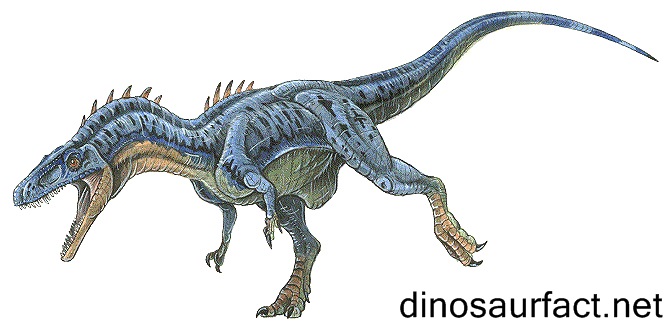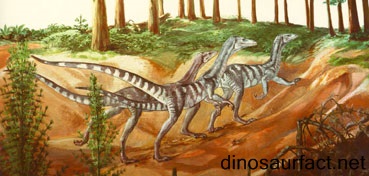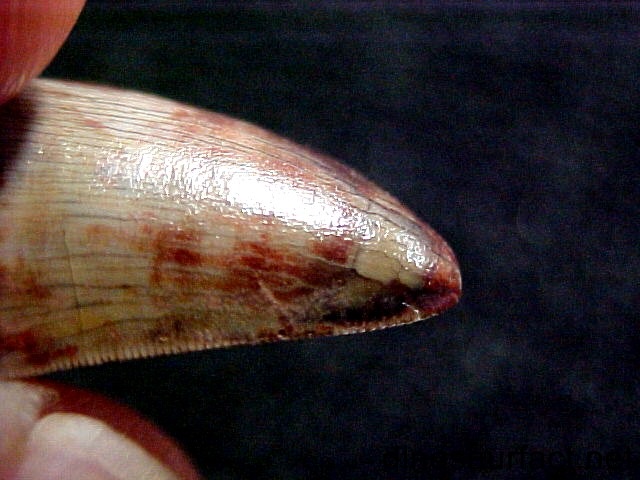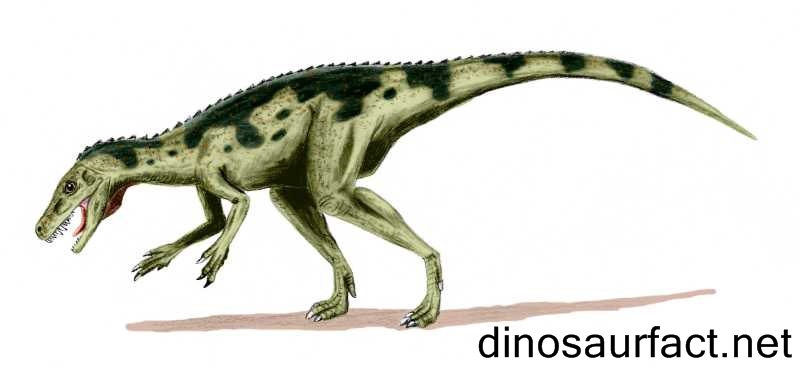 Click to visit the previous dinosaur bio
Click to visit the previous dinosaur bio
 |
|
 |
|
Kingdom: Animalia
Class: Reptilia
Superorder: Dinosauria
Order: Saurischia
Family: Herrerasauridae
Genus: Chindesaurus
 |
|
 |
|
 |
|

The Chindesaurus is a theropod dinosaur that existed in the latter half of the Triassic period. Like other species of sub order Theropoda, it was relatively small in size, could walk on two feet and was adapted for running.
It was extant about 220 to 212 million years ago. Its fossils were found in the southern and western regions of North America.
Etymology
The word 'Chiindii' means 'spirit' or 'specter' in Navajo, a language spoken the southern part of North American. The suffix '-saurus' translates to lizard in Latin. Thus, the name Chindesaurus is supposed to mean Ghost Lizard.
The remains of the Chindesaurus were became extremely well known owing to publicity in the media when they were discovered in 1985. They were given the eponym 'Gertie' after the 1914 Winsor McCay cartoon series, Gertie the Dinosaur.
The specific name Chindesaurus bryansmalli was derived from the discoverer of the fossils, Bryan Small. This name was suggested by Long and Murry.
Discovery of fossils
- The remains now ascribed to the Chindesaurus were first discovered in the Petrified Forest National Park in the Chinle Formation. This structure is present in Apache County, Arizona. They were excavated by paleontologist Bryan Small.
- Other fossils were also discovered in New Mexico which were later found out to belong to the Chindesaurus. These were present in the Bull Canyon Formation.
- The fossils found in the Hayden Quarry of the Chinle Formation of New Mexico were also presumed to belong to the Chindesaurus.
- A thigh bone was discovered in the Colorado City Formation in Texas which was also attributed to the Chindesaurus.
Classification
The classification of the Chindesaurus has seen many modifications and reevaluations. When the remains were first unearthed in 1985 by paleontologist Bryan Small, they were presumed to belong to a prosauropod. Their size and structure was similar to that of prosauropods.
- Long and Murry later classified the remains as those belonging to family Herrerasauridae. They believed it to be a theropod with characters matching a herrerasaurid.
- A study by Nesbitt and Irmis found that the remains of the Chindesaurus more aptly matched those of basal saurischians. They published a paper in 2007 stating so. This opinion was also held by Rauhut in 2003.
The most commonly accepted view in recent times is that the Chindesaurus was theropod dinosaur belonging to family Herrerasauridae. This stand still has many opponents though.
Bryan Small, Long and Murry
Bryan Small is a contemporary American Paleontologist. He has worked extensively in the Chinle Formation, uncovering many fossils of late Triassic and early Jurassic flora and fauna.
R. L. Long and P.A. Murry are vertebrae paleontologists who also have worked chiefly in the Chinle Formation. The have published many scientific papers about Upper Triassic fossils.
The Chinle Formation
The Chinle Formation is a natural geological structure that extends through Colorado, Utah, New Mexico, Nevada and Arizona. It is comprised of rivers, streams, lakes and even glacial material. The Chinle is considered by many to be related to the Dockum Group formation of New Mexico. The fossils in this structure are mainly from the Upper Triassic period.
There are many subunits of the Chinle Formation. Amongst those, the San Pedro Arroyo Formation (New Mexico), the Petrified Forest Formation (Arizona, Utah, and New Mexico) and the Santa Rosa and Shinarump Formation (New Mexico) are the most prominent.
The fossils of the Chindesaurus were discovered in Arizona and New Mexico.
Types of fossils found
The fossils of the Chindesaurus chiefly comprise of bones of the appendicular skeleton. These include a right femur, a right tibia, an incomplete left femur and some tarsal bones. The bones from the axial skeleton that are available include parts of the pelvic girdle, a few vertebrae and ribs.
Bones of the skull are conspicuously missing from amongst the remains.
The hip bones found in the Tecovas Formation were initially ascribed to the Chindesaurus but later attributed to a different genus Caseosaurus. It is still debatable whether the two were different dinosaurs or the same species, if not related.
Physical characteristics
The Chindesaurus was petit dinosaur weighing about 30 to 50 kilos. Its length was about 2 to 2.5 meters and it stood about 1 meter in height.
The hind limbs of the Chindesaurus were unusually long, as estimated by the femoral fossil. This was one the reasons for the divided opinions about its classification. It was bipedal and an excellent sprinter. It most likely had a strong tail.
Habits and habitat
The Chindesaurus was a terrestrial dinosaur. Most paleontologists agree that it was a carnivore. The swampy regions of southern America were the natural habitat of the Chindesaurus. It predated on aquatic organisms such as fish and shell fish.
Co-existing and related species
Many dinosaurs are thought to be very closely related to the Chindesaurus. The Herrerasaurus of South America may have been an organism derived from the Chindesaurus or vice versa. The Caseosaurus is also similarly related to the Chindesaurus, with many paleontologists being of the opinion that the Caseosaurus and Herrerasaurus may have been the same dinosaur.
All of the above mentioned dinosaurs may have coexisted. The Chindesaurus may also have coexisted with the other species which were found fossilized in the Petrified Forest formation such as phytosaurs and archosaurs. The Saurosuchus is considered by many scientists to have been present with the Chindesaurus and also its predator.
Current location of fossils
- The fossils found in the Petrified Forest Formation are currently housed in the University Of California Museum Of Paleontology, Berkeley. These include nine vertebrae, portions of the ilium and a femur, along with other bones.
- The fossils found in Bull Canyon Formation of New Mexico are preserved in the New Mexico Museum of Natural History and Science in Albuquerque, New Mexico.
- Texas Memorial Museum in Austin, Texas holds the remains found in the Hayden Quarry and the Colorado City Formation.
Concluding notes
A lot of information is available about the Chindesaurus due to the varied bone fossils discovered at multiple locations. The morphology, habits and contemporaries of the Chindesaurus are well established.
However, the exact taxonomic classification of the Chindesaurus has not yet been accurately determined. The bones attributed to the Chindesaurus show prosauropod, early saurischian as well as theropod characteristics. But most paleontologists agree that the theropod features are predominant.
The Chindesaurus could possibly be the same dinosaur as the Caseosaurus and/or the Herrerasaurus. Until more conclusive fossil evidence becomes available, the Chindesaurus may be considered a theropod.
Index
Extinct Profiles
 Triassic Dinosaurs
Triassic Dinosaurs Jurassic Dinosaurs
Jurassic Dinosaurs Cretaceous Dinosaurs
Cretaceous Dinosaurs Pterosaurs
Pterosaurs Marine Reptiles
Marine Reptiles Dinosaur Extinction
Dinosaur Extinction